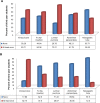What basic clinical procedures should be mastered by junior clerkship students? Experience at a single medical school in Tanzania
- PMID: 27051331
- PMCID: PMC4803256
- DOI: 10.2147/AMEP.S97916
What basic clinical procedures should be mastered by junior clerkship students? Experience at a single medical school in Tanzania
Abstract
Background: Clinical training in most medical schools, including the Catholic University of Health and Allied Sciences (CUHAS), is offered in the form of junior and senior rotations. During these clinical rotations, students are expected to acquire and master the basic procedural skills. However, students' learning process should be evaluated for quality improvement.
Objectives: This study was conducted to identify the basic medical procedural skills that third-year medical students should acquire and master and determine the level of students' exposure on these procedures at the end of junior rotation in internal medicine. Identification of the gap between clinicians' opinions, skills practiced by students, and third-year students' curriculum in the medical department at CUHAS was also done.
Methods: The descriptive cross-sectional study was used to collect data through a self-administered, structured questionnaire from clinicians in medicine. A review of logbooks was considered to determine level of students' exposure, and a document analysis was done using existing medical curriculum.
Results: The response of 71% (n=22) was obtained. Clinicians agreed on basic procedures that students should perform independently (ie, Foley catheter insertion, venipuncture, and intravenous drip insertion). Clinicians thought that lumbar punctures, abdominal paracentesis, and nasogastric tube insertion should be done under minimal supervision. A considerable number of students (25%, n=75) did not practice any procedure throughout their rotation. The majority of the students performed venipuncture independently (82.14%, n=56) and lumbar punctures (73.21%, n=56) under supervision. Less than 25% (n=56) of the students met the required number of exposures on the basic procedures. The procedures to be performed and the level of competency in the procedures are not specified in the current curriculum.
Conclusion: The study identified the procedures that should be taught and practiced by students. It also highlighted the discrepancies in the existing curriculum and the need to monitor and supervise students' practice.
Keywords: Tanzania; basic procedures; clinical clerkship; internal medicine rotation; logbooks; medical education; procedural skills.
Figures
References
-
- Wu EH, Elnicki DM, Alper EJ, et al. Procedural and interpretive skills of medical students: experiences and attitudes of third-year students. Acad Med. 2006;81(10 Suppl):S48–S51. - PubMed
-
- Sanders CW, Janine CE, Thomas KB. A survey of basic technical skills of medical students. Acad Med. 2004;79(9):873–875. - PubMed
-
- Langdale AL, Doug S, Joyce W, Susan Ml, Louis V, Craig SS. Preparing graduates for the first year of residency: are medical schools meeting the need? Acad Med. 2003;78(1):39–44. - PubMed
-
- Burch VC, Nash RG, Zabow T, et al. A structured assessment of newly qualified medical graduates. Med Educ. 2005;39:723–731. - PubMed
LinkOut - more resources
Full Text Sources
Other Literature Sources
Miscellaneous



